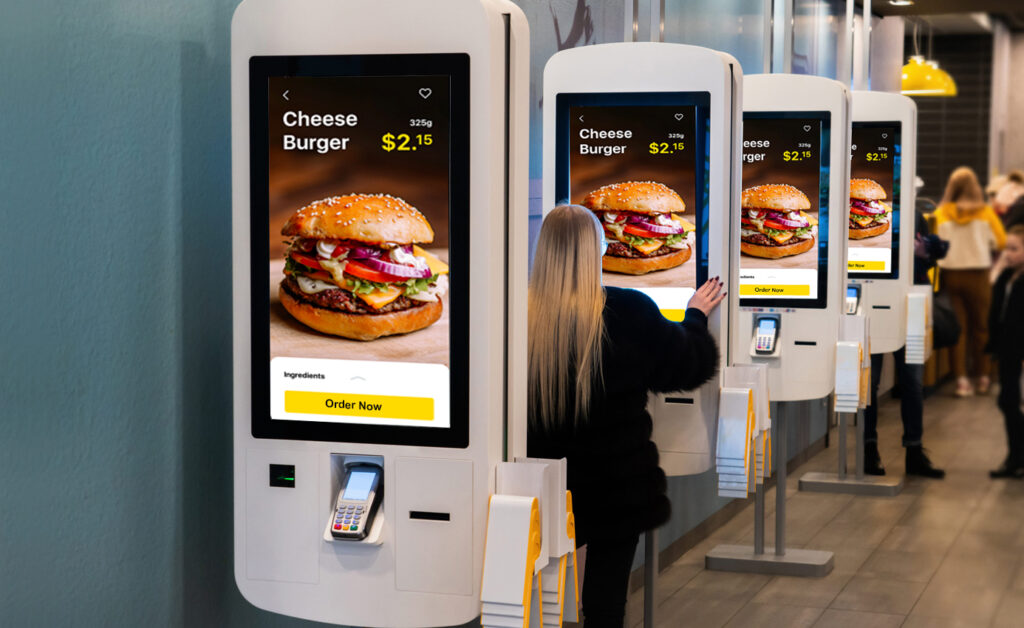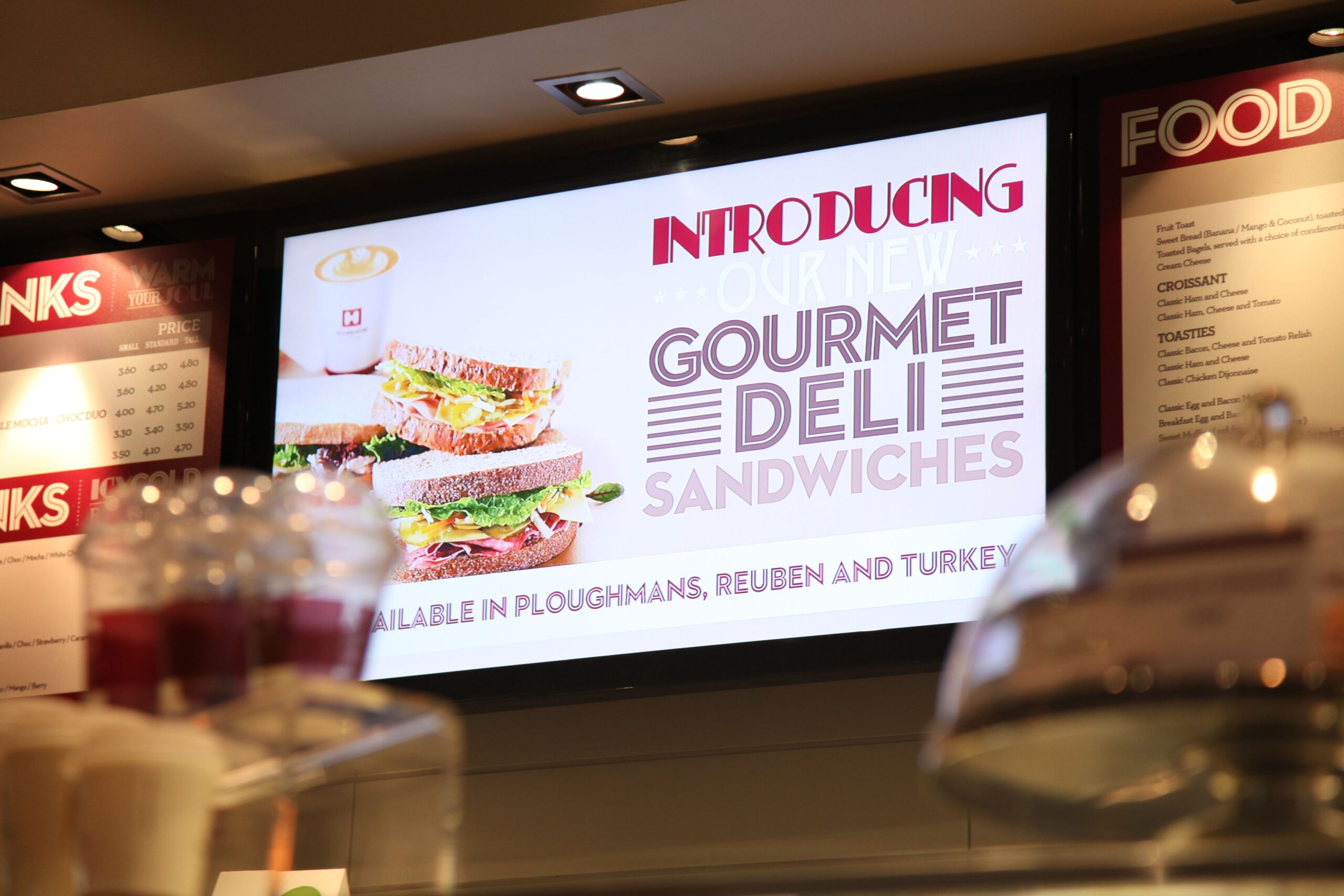Indoor digital menu boards an displays are essentially high-impact electronic displays used to showcase a restaurant or business’s menu items. Unlike printed menus, these boards are typically placed indoors, such as near the counter or inside the restaurant. You can easily update and change them to reflect new menu items, specials, or promotions within minutes.
With indoor digital menu boards, changes to the menu can be made quickly and easily. Hence, this saves you both time and money. Additionally, Digital menu boards can be used to showcase more than just menu items. They can display photos, videos, and other engaging content to help promote the restaurant or business.
In this article, we will provide you with everything you need to know about indoor menu boards. This will help you boost your indoor dining experience, and increase sales and loyalty.
Indoor Digital Menu Boards & Displays Benefits
Improved customer experience:
Digital menu boards take part in Visual Marketing, it provide customers with a more visually appealing and engaging experience. Besides, they allow for dynamic content creation, such as high-quality images and videos.
This can enhance the customer’s perception of the restaurant and make them more likely to order additional items. Digital displays can also be programmed to display promotions or promote special offers that can lead to driving impulse buys.
Increased sales and profitability:
Digital menu boards can help increase sales and profitability in several ways. They can highlight menu items that are more profitable, encourage upselling or cross-selling, and promote new or seasonal items.
They can also be updated in real-time to reflect changes in pricing or inventory, allowing restaurants to respond quickly to market trends or customer demand.

Better control over menu updates:
Restaurant owners have greater control over menu updates. Changes can be made quickly and easily, eliminating the need to print new menus or make manual updates. This can save time and money. And also ensure that customers always have access to all the information they need regarding menu items and pricing.
More efficient use of space:
Digital menu boards take up less physical space , allowing restaurants to use the space for other purposes. They can display multiple menus or menu items on a single screen. This can reduce clutter and make it easier for customers to find what they are looking for.
Greater flexibility and versatility:
Digital menu boards offer greater flexibility and versatility. They are programmed to display menus at different or even specific times of the day. And Also to show different items based on the weather or customer demographics. They can be equally used for other purposes. For example, displaying news or entertainment content to help create a more engaging atmosphere for customers.
Types of Indoor Digital Signage Solutions

Wall-mounted displays
These are digital screens that are mounted on walls in restaurants, cafes, and other indoor food establishments. They can range in size from small screens to large displays, and can be either static or dynamic.
Static displays show a set menu, while dynamic displays can be programmed to change throughout the day, showing different lunch and dinner menus. On the other hand, Wall-mounted displays are a popular choice. They are easy to install and can be seen by customers from anywhere in the restaurant.
Free-standing kiosks:
These are standalone digital displays that are placed on the floor and are usually interactive. Standalone Kiosks can be similar to drive-thru menus.They both provide a means for customers to interact with a self-service system to place orders or make selections.They allow customers to browse the menu, place orders, and pay for their food without having to interact with a cashier. Free-standing kiosks are particularly popular in fast-food chains and quick-service restaurants, where speed and convenience are important.
Tablet-based systems:
These are digital menus that are displayed on tablets, which are usually mounted on stands or placed on tables. Customers can browse the menu, place orders, and pay for their food using the tablet. Tablet-based systems are popular in casual dining restaurants, where customers can take their time to browse the menu and make their selections.
Interactive menu boards:
These are digital screens that are touch-sensitive, allowing customers to interact with the menu by selecting items, customizing their orders, and adding or removing items from their order. Interactive menu boards are popular in restaurants that offer a lot of customization options, such as fast-casual restaurants or cafes that offer build-your-own options.
Features and Functionality of Digital Menu Boards
Customizable templates and layouts:
Indoor digital menu boards come with pre-designed customizable board templates and layouts that allow you to easily create eye-catching and visually appealing menus that fit your brand’s aesthetics.
You can choose from a range of different designs, fonts, colors, and themes to create a menu display that best represents your brand.
Easy-to-use content management systems:
The content management system (CMS) of an indoor digital menu board gives you the ability to change and easily manage your menu content from a central location.
You can make changes to your menu items, pricing, and images, and publish them to your menu board with just a few clicks. The CMS makes it easy to keep your menu up-to-date and relevant to your customers.
Dynamic pricing and menu updates:
Indoor digital menu boards allow you to easily update your menu with dynamic pricing changes based on factors such as time of day, day of the week, or special promotions.
This means you can quickly and easily update your menu prices without the need to reprint menus, saving you time and money.
Integration with POS systems and other software:
Indoor digital menu boards can be integrated with your point-of-sale (POS) system and other software, allowing you to automate the process of updating your menu prices and item availability.
This integration streamlines your operations and reduces the risk of errors or discrepancies between your menu and POS system.
Multimedia content capabilities:
Indoor digital menu boards have multimedia content capabilities, which means you can display videos, images, and other dynamic content on your menu board to engage your customers and enhance their experience.
This feature is particularly useful for showcasing high-quality images of your food items, promotions, or other marketing messages. Videos can be used to demonstrate cooking techniques or show the preparation of dishes, helping customers to visualize and understand what they are ordering.
Best Practices for Implementing Digital Menu Boards
Understanding the needs and preferences of your target audience:
It’s important to understand your target audience and their needs and preferences when designing and implementing your indoor digital menu board. This will help you to create content that resonates with them and engages them effectively. For example, if your target audience is primarily health-conscious, you might want to highlight nutritional information or offer healthy options on your menu.
Choosing the right hardware and software solutions:
When selecting hardware and software solutions for your indoor digital menu board, it’s important to choose solutions that are reliable, user-friendly, and provide the features and functionality you need. Consider factors such as screen size, resolution, and compatibility with your existing POS system.
Developing engaging and informative content:
The content on your indoor digital menu board should be engaging, informative, and visually appealing. Use high-quality images and videos, and highlight key information such as pricing, nutritional information, and special offers. Keep your content updated regularly to keep customers interested and informed.
Consistent branding and messaging:
Your indoor digital menu board should reflect your brand’s messaging and values, and should be consistent with your other marketing materials. Use the same fonts, colors, and design elements as your other marketing materials to create a cohesive brand identity.
Regular maintenance and updates:
To ensure that your indoor digital menu board continues to function properly and provide an optimal customer experience, it’s important to perform regular maintenance and updates. This may include updating your software, checking for hardware issues, and cleaning the screen regularly. Regular updates to your content will also keep customers engaged and informed about your menu offerings.
Want to invest in a Indoor Digital Menu Board but don’t know where to start?
Display. Stream is a digital signage company that specializes in providing cloud-based solutions for creating, managing, and delivering digital content to displays, screens, and interactive kiosks.
Display. Stream allows businesses to create and manage dynamic and engaging digital signage content, such as videos, images, and interactive applications, to communicate messages, promotions, and information to their audience in real-time.
Here are some of the main perks that Display.Stream offers:
- It’s FREE !! Once you sign up, you will get your first display for free and only pay between $5 and $7 for the next display!
- From a smartphone or laptop, you can create amazing design and content, and broadcast to multiple screens and displays.
- Have built players for all platforms, which means it works with any hardware and operating system.
- Helps you save money ! Once you sign up, you will be granted access to all available design templates.
These are just some perks offered by Display.Stream as they vary depending on the plan you choose. The good news : all plans are customizable, so join us, and pick the right plan for you to take your business to the next level!
Conclusion
Digital indoor menu boards offer many benefits for businesses looking to improve their customers’ experience and streamline their operations. With dynamic content capabilities, flexibility, and increased efficiency, digital menu boards are visually attractive and engaging, making them a valuable investment for many businesses. However, businesses should also consider potential challenges such as upfront costs, technical difficulties, and customer preferences. By conducting thorough research, choosing a reliable vendor, developing a content management plan, and training staff on the system, businesses can successfully implement indoor digital menu boards to enhance their operations and improve the customer experience.
